![]() January - February 2003
January - February 2003
Outdoor Smarts
The Pack on Your Back
By Karen Berger
Photographs By John R. Fulton Jr.
External- or internal-frame? The choice depends on the terrain you plan to hike and whether you are a youth or an adult.
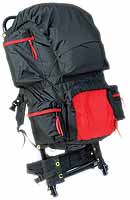 Black Bull Horizon Combo (BSA No. Z01344, $145). This 3,312-cubic-inch pack features a top-loading main compartment and an easy-access, front-loading lower zipper compartment. An extender bar adds nine inches of height above the pack to lash extra gear onto the frame. Available from local BSA Supply distributors or by calling (800) 323-0732. |
Buying the right backpack is one of the most important decisions a hiker will make. A well-chosen pack can mean the difference between hiking in comfort or pain, and a good pack can last a lifetime.
While both adults and young people need packs that can comfortably haul gear from Point A to Point B, there are different items to consider when choosing a pack for an adult or child.
There are two kinds of backpacks most often seen on the trail—internal frame and external frame.
Internal frames
The original internal-frame packs, developed by mountaineers, were basically big, top-loading duffel bags where hikers stuffed all their gear. The concept hasn't changed, although many of today's models have outside compartments, plus front and bottom zipper access for organizing gear.
Internal-frame packs have some important advantages. First, the weight is held close to the back, with a low center of gravity, which makes climbing, scrambling, or cross-country skiing with one easier. (Manufacturers such as Gregory, Dana Design, Osprey, Lowe Alpine, and Mountainsmith offer internal-frame packs with multiple adjustments to fine-tune the fit for maximum comfort.)
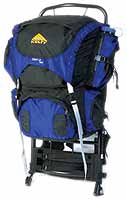 Kelty Yukon 3500 ($100). Designed for the growth spurts of young hikers, the pack's telescoping H-frame fits a torso range of 16 to 21 inches. Designed with a water bottle pocket and six easy-access gear pockets, this pack is a good choice for weekend trips. Go to www.kelty.com for a list of dealers in your area. |
Another advantage is that everything goes inside, protected from snow and rain, with no worry about losing or damaging gear tied on the outside of the pack.
There are also a few disadvantages. To ride comfortably, an internal-frame pack needs to be fitted more carefully. And because it hugs the lower back, it may be uncomfortable for some hikers in hot weather (or for those who sweat heavily). Also, some models do not offer enough pouches and compartments.
Finally, many internal-frame packs are heavier than their external-frame counterparts, and can also be more expensive.
External frames
External-frame packs are sacks attached to a metal frame. Most have several compartments and pouches, making it easier to find what you need. However, a tent and/or a sleeping bag usually ride outside the main compartment, where they are more vulnerable to weather.
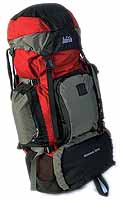 REI Morning Star 75 ($145). This 4,950-cubic inch internal frame pack is a good size for multiday backpacking trips. It features top and bottom compartment access and lots of zippered organizing pockets. Dual water bottle pockets allow access to liquids without taking off the pack. Available at REI retail locations, from www.rei.com; or phone (800) 426-4840. |
An external-frame pack has a distinctly different feel, because the weight is distributed over a larger area and the pack tends to ride higher. On well-groomed trails, this weight distribution is comfortable, but when scrambling off trail, many hikers find that the higher center of balance can interfere with agility.
The fit of an external-frame pack can't be customized as well as an internal-frame pack. But while you lose something in comfort, you gain in versatility, because an external-frame pack with an adjustable frame can fit a wider range of hikers. This is especially convenient if your load includes a closetful of group equipment.
Filling it up
Pack capacity is measured in cubic inches. Figure about 3,500 cubic inches for summer weekends, 4,000 to 4,500 cubic inches for three- to five-day trips, and 5,000-plus for expeditions and cold-weather hiking.
Leaders should look for a pack that has a little extra room so they can take on extra group gear or help lighten the load of a hiker who is having trouble. Look for packs that allow you to attach extra compartments or strap things outside.
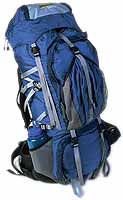 Gregory Mountain Products Lassen ($310). This top- and front-loading internal frame pack features many ways to customize its fit, including shoulder harnesses that rotate to match the slope of your shoulders and neck width for added mobility and comfort. The top pocket converts to a fanny pack. Go to www.gregorypacks.com for a list of dealers in your area or call (800) 477-3420. |
Getting the right fit
The most important factor in pack-fitting is torso length, which is measured from the bump in the back of your neck (the C-7 vertebra) to the iliac crest near the small of your back.
Wayne Gregory, one of the industry's most innovative designers, suggests this technique: Put your hands on your hipbones, thumbs pointing backwards. The point where imaginary lines from each thumb meet is the iliac crest.
Some packs, especially high-end internal-frame packs, are designed to be custom fitted to the hiker's body. This should be done at a store where the salespeople have been trained by the manufacturer. Be sure to try the pack on in the store with at least 15 to 20 pounds of weight in it.
Considerations for youth
Parents know that children quickly outgrow clothes and shoes, and that goes for backpacks, too.
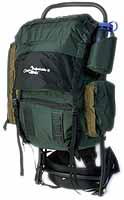 Camp Trails Adjustable Pack (BSA No. Z01304, $104). This 3,330-cubic-inch pack features a telescoping frame that can be fitted to "grow" with a Scout. Designed to fit a torso range of 15 to 23 inches. Available from local BSA Supply distributors or by calling (800) 323-0732. |
External-frame packs are the best choice for most youngsters. They tend to be less expensive and are often lighter in weight. Most importantly, many external-frame packs can be adjusted as your child grows.
Look for an adjustable pack frame that has a torso range starting at your child's present length. The wider the range, the longer it will work for your child.
A final word: The most comfortable pack is the one with the least weight. No matter which pack you choose, try to keep the load inside as light as possible.
Karen Berger answers hundreds of reader questions in her new book, More Everyday Wisdom: Trail-Tested Advice From the Experts (Mountaineers Books). Visit her at www.HikerWriter.com.
Current Issue |
Archives
January-February 2003 Table of Contents
Copyright © 2003 by the Boy Scouts of America. All rights thereunder reserved; anything appearing in Scouting magazine or on its Web site may not be reprinted either wholly or in part without written permission. Because of freedom given authors, opinions may not reflect official concurrence.
| The Boy Scouts of America | http://www.scouting.org |